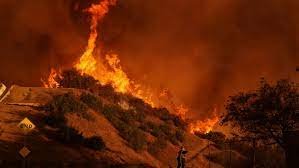
Scientists and environmentalists are racing to assess the potential damage caused to the Pacific Ocean by the recent Los Angeles wildfires. The Palisades and Eaton fires have not only scorched thousands of homes and businesses but have also left behind hazardous debris that is now finding its way into coastal waters.
Concerns Over Ocean Contamination
Mudslides and debris flows in the Palisades Fire burn zone have transported hazardous waste into the ocean. Burned soil, which repels water, struggles to absorb rainfall, leading to increased runoff carrying toxic ash, chemicals, and debris into the sea.
On a recent assessment drive along the Pacific Coast Highway, Tracy Quinn, President and CEO of environmental group Heal the Bay, observed widespread pollution. Ash-darkened shorelines, burned appliances, and sludge-laden waters painted a grim picture. “It was just heartbreaking,” Quinn said, noting reports of ash and debris reaching up to 25 miles (40 kilometers) south of the burn area.
The devastation raises concerns about how fires on land are affecting marine ecosystems. The burning of homes, vehicles, and electronics has released hazardous substances such as pesticides, asbestos, plastics, lead, and heavy metals into the air and water. Scientists fear these pollutants could impact marine life and even the human food supply.
Hazards to Water Quality and Marine Life
Strong winds during the fires carried ash and smoke far beyond the blaze zones, eventually settling into the ocean. Researchers aboard a University of California, San Diego, Scripps Institution of Oceanography vessel detected fire debris as far as 100 miles (161 kilometers) offshore. Marine ecologist Julie Dinasquet described the scent of the contamination: “not like a nice campfire,” but rather the smell of burning electronics.
Post-fire rainfall exacerbated these concerns, washing contaminants from burned areas into the ocean. “Runoff can carry heavy metals, nitrogen, phosphate, and polycyclic aromatic hydrocarbons (PAHs), which result from burning fuel and can be harmful to marine life,” said Mara Dias, a water quality manager at the Surfrider Foundation.
Mudslides and debris flows in burn zones further increase the risk of toxic waste reaching the ocean. Fire-scorched soil is less capable of absorbing water and, when combined with the loss of organic material that stabilizes the ground, can lead to massive erosion.
Government Response and Cleanup Efforts
Los Angeles County officials, with support from state and federal agencies, have implemented protective measures to mitigate further environmental damage. Thousands of feet of concrete barriers, sandbags, and silt socks have been deployed to prevent debris from reaching the coast. Additionally, the LA County Board of Supervisors has sought state and federal assistance to expand beach cleanups, prepare for storm runoff, and conduct extensive water quality testing.
State water officials are testing ocean samples for toxic metals, volatile organic compounds, microplastics, and other hazardous chemicals such as polychlorinated biphenyls (PCBs), which have been linked to cancer and serious health issues.
While initial chemical tests last month did not indicate immediate health concerns, county public health officials continue to advise beachgoers to avoid ocean waters. “We will continue rigorous testing to ensure public and marine safety,” an official statement read.
The Road Ahead
As cleanup efforts continue, scientists and environmental groups are closely monitoring the long-term effects of the wildfire contaminants on marine ecosystems. With Los Angeles’ coastal waters playing a crucial role in both tourism and marine biodiversity, researchers stress the urgency of mitigating further damage and preventing similar incidents in the future.
Sources By Agencies


